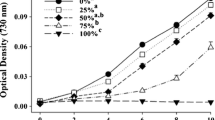Abstract
Cells of the diatomCyclotella meneghiniana were exposed in a closed system to 0.095 ppm pentachlorobenzene over a period of 5 days. Changes in fatty acid and morphological percent composition were monitored to determine the effect of the toxicant. The greatest morphological change observed was an increase in lipid volume. Most morphological changes occurred in the 1 hour and 5 day sampling periods. Few changes in morphological characteristics or fatty acid percent composition were observed at eight hours, when the cells were in the dark. The C18∶1 and C20∶5 fatty acids were most variable with exposure to pentachlorobenzene. Results suggest that at sublethal doses, lipophilic toxicants exert effects that are biphasic. That is, immediately measurable effects are observed in the cells that include increases in storage products and changes in membranous organelles. Long-term effects are postulated to be the result of mobilization of lipophilic toxicants that have partitioned into lipid stores and are more available when lipids are metabolized. Although pentachlorobenzene has a higher octanol/water partition coefficient, it appears to exert fewer cellular changes than any trichlorobenzene isomer.
Similar content being viewed by others
References
Arnold DE (1971) Ingestion, assimilation, survival, and reproduction byDaphnia pulex fed seven species of bluegreen algae. Limnol Oceanogr 16:906–919
Borgmann U, Whittle DM (1983) Particle-size-conversion efficiency and contaminant concentration in Lake Ontario biota. Can J Fish Aquat Sci 40:328–336
Brooks AS, Torke BG (1977) Vertical and seasonal distribution of chlorophyll a in Lake Michigan. J Fish Res Board Can 34:2280–2287
Butler NM, Suttle CA, Neil WE (1987) Discrimination by zooplankton between phytoplankton cells of different nutritional status. Abstract, 50th Amer Soc Limnol Oceanogr Meeting
Eadie BJ, Chambers RL, Gardner WS, Bell GL (1984) Sediment trap studies in Lake Michigan: Resuspension and chemical fluxes in the southern basin. J Great Lakes Res 10:307–321
Evans MS, McNaught DC (1988) The effects of toxic substances on Zooplankton populations: a Great Lakes perspective. In: Evans MS (ed) Toxic Contaminants and Ecosystem Health: A Great Lakes Focus. Wiley Interscience. pp 53–76
Evans MS, Bathelt RW, Rice CP (1982) PCBs and other toxicants inMysis relicta. Hydrobiologia 95:205–215
Fisher NS, Guillard RRL, Wurster CF (1976) Effects of a chlorinated hydrocarbon pollutant on the growth kinetics of a marine diatom. In: Canale RP (ed) Modeling Biochemical Processes in Aquatic Ecosystems. Ann Arbor Science, Ann Arbor, MI, pp 305–317
Frank R, Thomas RL, Holdrinet M, Kemp ALW, Brown HE (1979) Organochlorine insecticides and PCB in surficial sediments (1968) and sediment cores (1976) from Lake Ontario. J Great Lakes Res 5:18–27
Frank R, Thomas RL, Braun, HE, Rasper J, Dawson R. (1980) Organochlorine insecticides and PCB in the surficial sediments of Lake Superior (1973). J Great Lakes Res 6:113–120
Frank R, Thomas RL, Braun, Gross DL, Davies TT (1981) Organochlorine insecticides and PCB in surficial sediments of Lake Michigan. J Great Lakes Res 7:42–50
Gannon JE, Beeton AM (1969) Studies of the effects of dredged materials from selected Great Lakes harbors on plankton and benthos. Univ Wisc-Milwaukee, Center for Great Lakes Studies Special Report No. 8
Geyer H, Politzki G, Freitag D (1984) Prediction of ecotoxicological behaviour of chemicals; Relationship betweenn-octanol/water partition coefficient and bioaccumulation of organic chemical by algaeChlorella. Chemosphere 13:269–284
Gliwicz MZ, Sieniawska A (1986) Filtering activity ofDaphnia in low concentrations of a pesticide. Limnol Oceanogr 31:1132–1138
Halfon E, Reggiani MG (1986) On ranking chemicals for environmental hazard. Environ Sci Technol 20:1173–1179
Hannan PJ, Patouillet C (1972) Effect of mercury on algal growth rates. Biotech Bioengn 14:93–97
Hutchinson TC, Hellebust J, Tam D, Mackay D, Mascarenhas RA, Shiu WY (1980) The correlation of the toxicity to algae of hydrocarbons and halogenated hydrocarbons with their physical-chemical properties. In: Afghan BK, Mackay D (eds) Hydrocarbons and Halogenated Hydrocarbons in the Aquatic Environment. Plenum, New York. pp 577–586
McNaught DC (1982) Short cycling of contaminants by zooplankton and their impact on Great Lakes ecosystems. J Great Lakes Res 8:360–366
Reinheit RE (1972) Accumulation of dieldrin in an alga (Scendesmus obliquus)Daphnia magna, and the guppy (Poecilia reticulata). J Fish Res Board Can 29:1413–1418
Richman S, Dodson SI (1983) The effect of food quality on feeding and respiration byDaphnia andDiaptomus. Limnol Oceanogr 28:948–956
Schelske CL, Stoermer EF, Feldt LE (1971) Nutrients, phytoplankton productivity and species composition as influenced by upwelling in Lake Michigan. Proc 14th Conf Great Lakes Res, pp 102–113
Sicko-Goad L, Hall J, Lazinsky D, Simmons MS (1989a) Effects of chlorinated benzenes on diatom fatty acid composition and quantitative morphology. II. 1,3,5-trichlorobenzene. Archiv Environ Contam Toxicol 18:638–646
— (1989b) Effects of chlorinated benzenes on diatom fatty acid composition and quantitative morphology. III. 1,2,3-trichlorobenzene. Archiv Environ Contam Toxicol 18:647–655
Sicko-Goad L, Lazinsky D, Hall J, Simmons MS (1989c) Effects of chlorinated benzenes on diatom fatty acid composition and quantitative morphology. I. 1,2,4-trichlorobenzene. Archiv Environ Contam Toxicol 18:629–637
Sicko-Goad L, Simmons MS, Lazinsky D, Hall J (1988) Effect of light cycle on diatom fatty acid composition and quantitative morphology. J Phycol 24:1–7
Stoermer EF, Wolin JA, Schelske CL, Conley DJ (1985) An assessment of ecological changes during the recent history of Lake Ontario based on siliceous algal microfossils preserved in the sediments. J Phycol 21:257–276
Warwick WF (1988) Morphological deformities in Chironomidae (Diptera) larvae as biological indicators of toxic stress. In: MS Evans (ed.). Toxic contaminants and ecosystem health: A Great Lakes focus. John Wiley & Sons, New York. pp 281–320
Wong, PTS, Chau YK, Rhamey JS, Docker M (1984) Relationship between water solubility of chlorobenzenes and their effects on a freshwater green alga. Chemosphere 13:990–996
Author information
Authors and Affiliations
Rights and permissions
About this article
Cite this article
Sicko-Goad, L., Evans, M.S., Lazinsky, D. et al. Effects of chlorinated benzenes on diatom fatty acid composition and quantitative morphology. IV. Pentachlorobenzene and comparison with trichlorobenzene isomers. Arch. Environ. Contam. Toxicol. 18, 656–668 (1989). https://doi.org/10.1007/BF01225004
Received:
Issue Date:
DOI: https://doi.org/10.1007/BF01225004




